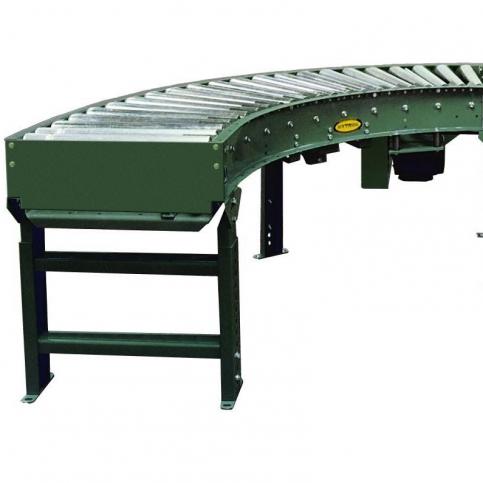Accumulation conveyor systems are used widely in industries where there are a variety of products that need to be sorted. They have the ability to remove drive in particular zones of a conveyor so that products can collect, or accumulate, there. These zones of stopped products can then be integrated into other parts of a conveyor system such as merges, sorters, or palletizers. There are two types of accumulation conveyors, namely minimum pressure and zero pressure conveyors.
First, we will go over the differences between these two types of systems.
Minimum pressure:
in minimum pressure systems, the products, whether in carton or parcel form, accumulate behind a stop or meter belt. Each product stops against the stopped product ahead of it, thus forming a train or “accumulation” of products. However, the rollers continue to run under the train of items, thus creating pressure. Typically, the amount of pressure can be controlled by built-in mechanisms.
- Benefits: minimum pressure accumulators are usually less expensive and require less maintenance than zero pressure accumulators.
- Uses: they work best with consistent package sizes and weights, as well as over short distances.
Zero pressure:
zero pressure systems have sensing capabilities that cause products to be stopped in a particular zone on the conveyor. The rollers cease running, thus creating no pressure. In this case, the products do not touch each other while conveying, unlike in minimum pressure systems where products do lightly touch.
- Benefits: zero pressure systems are known to be highly energy efficient and are capable of conveying products of varying sizes and weights.
- Uses: this accumulation conveyor works just as well in distribution centers, parcel service providers and more, but with an added advantage when it comes to a wider variety of products and longer distances.
The main difference between these two conveyor types is the method by which they achieve accumulation: pneumatically or mechanically. Mechanical accumulation does not require plant air, and is thus more energy efficient.
Now, let’s get into the various types of accumulation conveyors supplied by Norpak Handling:
Norpak Handling is a leading Hytrol Integration Partner, bringing world-class Hytrol products to Canada. Our line of accumulation conveyors are sourced from Hytrol, a world leader in the design and manufacturer of material handling systems.
Minimum pressure systems:
- ACC: This conveyor is considered to be the simplest method for accumulation. It has a basic design, thus eliminating the need for complex adjustments. It allows a minimum 2% back pressure and features fingertip snub roller adjustments, getting rid of the need for tools.
- ACZ: This model is similar to the ACC except that a 6-inch or 8-inch wide flat belt is used instead. It utilizes a center drive which can be placed in any section of the conveyor length, and like the ACC, is also reversible.
Zero pressure systems:
- ABEZ: This model is a pneumatically-operated horizontal belt driven live roller conveyor, best used in applications where accumulation without a build-up of line pressure is required. This conveyor also features dynamic zone allocation technology. A flat drive belt supplies each zone with power.
- LREZ: Similar to the ABEZ, this model is also pneumatically operated except it has heavy duty 2.5-inch diameter rollers, with a low profile design. It is a heavy duty conveyor and comes with a compact drive.
- NBEZ: This model is a horizontal belt driven live roller conveyor, designed for applications that require no line pressure buildup during accumulation as well as high throughput and density. It utilizes 24VDC electro-magnet actuation to engage the pressure carriage. It is operated electrically.
- NSPEZ: This horizontal line shaft driven conveyor has dynamic zone allocation, which, thanks to positive breaks on each roller, allows you to stop product in each zone.
- E24EZ: This model utilizes a series of 24VDC motors to drive the tread rollers, eliminating drive belts, chains, or line shafts. It features quiet operations and easier maintenance as well as installation. It is completely electrically operated.
- BZE24EZ: Like the E24EZ, this accumulation conveyor also uses a series of 24VDC motors to drive full width of the belt over roller zones. Its all-electric operation is quiet when operating and reduces belt friction. It also comes with a direct drive roller.
Each of these conveyors is divided into accumulation zones, wherein Hytrol’s EZLogic Zone Controllers are able to sense product presence and control product accumulation and release.
No matter your accumulation conveyor needs, we at Norpak Handling can find the right solution for you. Call us at 1-800-854-6054 or visit our website to see what we can do for you.










